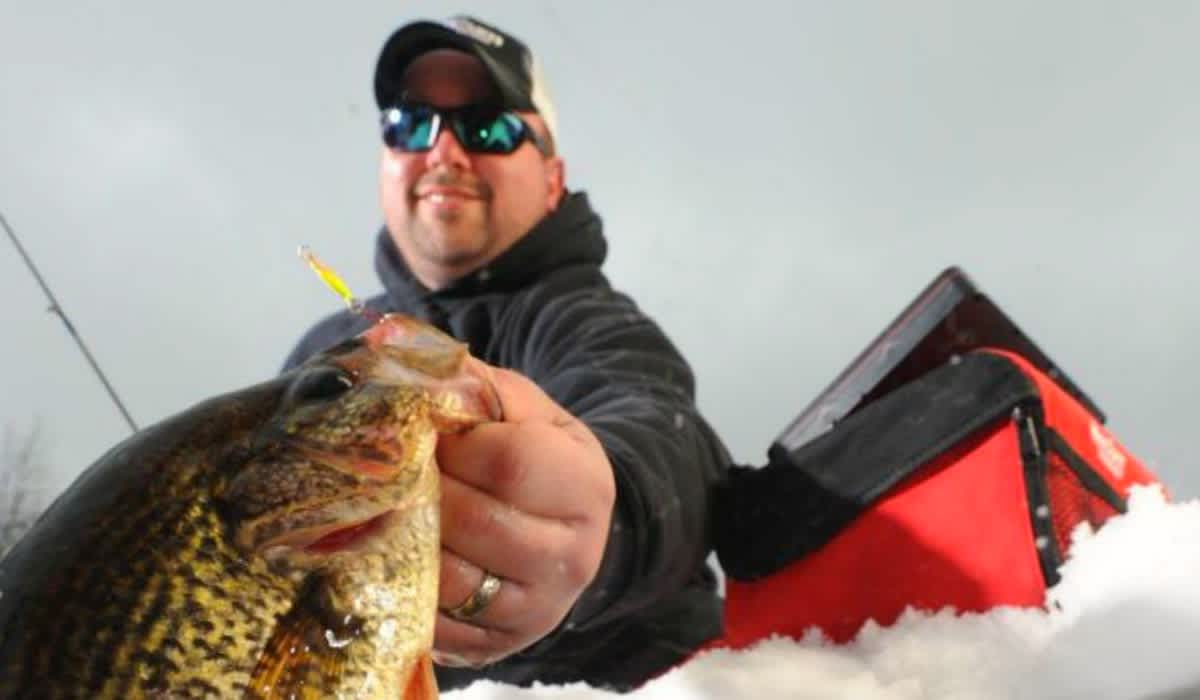Guide-Tested Winter Jigging Tips: Bluegills and Crappies
Joel Nelson 03.06.18

Part one of this two-part series focused heavily on the idea that each walleye or perch has its own mood, persona, and likes/dislikes. Bluegills take this idea to a new level, often being among the most challenging species to trigger during an off-bite.
I’ve sat on schools of giant gills for upwards of 3 days, revisiting them from time to time until weather stabilized and their outlook on eating improved. In high-front situations, with bluebird skies and spiked barometers, sometimes there’s very little you can do. While it happens, those lock-jaw moments are rare, and more often you’re left with a challenging, yet possible bite scenario tied to a specific color, jigging stroke, or low-light feeding window.
Bluegills
Trophy midwinter panfish are legendarily difficult to coax. Over the years of photo and film-shoots, we would focus efforts early and late in the ice season to specifically avoid a closed-mouth session of bad-water bluegills.
If you’re learning how to jig them into submission during midwinter, your best bet is to focus on the third or fourth day of consistent weather, and a stable or falling barometer. Pair this with at least a half day on the ice to aid in your cumulative learning, either preceding or into and then out of a low-light period.

Big gills hang in the water column nicely, as relatively stationary and solid targets on your flasher. Your first opportunity to impress is on the drop, so resist a hasty drop into a new school until you have your wits about you. Some baits simply drop better than others, so watch your bait for the first few feet to see what it looks like. Hopefully there’s no spin, and the fall looks natural.
Spinning reels and finicky gills have single-handedly brought upon the heavy selection of in-line or straight-line reels these days, which allow line to be evenly placed on a spool without line twist. Focus on slowly dropping your bait into a school of fish on a slack line. Are they rising to meet, or spooking in a refusal to eat?
The next drop, try an artificial introduction to the fish on a tight line as you steadily control the bait’s fall until just above them. Sneak it in. Then start jigging. Again, focus on initial reactions from your flasher. Does an aggressive lift draw them closer, or does a more subtle jigging stroke tickle their fancy?

Technical gill bites are cause for a two-step process that I like to call “lock-down” and “lift.” I palm the reel, placing the rig on my thigh or hip while kneeling on the ice. This settles and steadies my hand, allowing for some more fine motor-skill movements. From here, I tap the rod blank with a forefinger to attract, then squeeze the rod handle in quick but subtle bursts to get the fish to commit. As reluctant fish close, or as they retreat, I start a slow but steady lift to hit the reset button. I will drop on a slack line or slow and tight line depending on what my early research has shown to be most effective, only to start the process all over again.
Of course, each jig fishes differently based on design. These are general starting points from which to form your own opinions and best-practices, but keep them in mind next time you tackle a tough gill bite for which there seems no remedy.
Crappies
During much of the ice season crappies are easy pickings by comparison, mostly because they suspend over deeper water, giving our sonar cones a chance to grow in diameter and scan a larger underwater area. Bigger crappies, however, are often found in weeds or roaming edges instead of basins, such that they’ll often jig up like a less-eager walleye.
For finicky crappies, your challenge to jigging is often two-fold: control of the jig is of great importance, but it’s made difficult by deep water and small jig sizes. On light bites, I’ll err toward the side of bite detection with a stiffer-than-normal noodle style rod; when fish are a bit more willing to chew, I’ll use a stronger power and faster-action rod than normal for better control.

Crappies will often stratify according to size on your graph, with the better fish in the school either feeding high, or more often, sitting lower in the water column and protected by more enthusiastic biters above them. In such situations, fish fast with heavier tungsten or spoons to blow past the little guys, but still stay above the better fish. Crappies seem more unwilling to follow a bait down, with bluegills, and then especially perch being more willing to chase down.
For that reason, your crappie jigging cadence should be upward-centric. The up-down keep-away game seems to work only with the very most aggressive crappies, and you’ll need to keep the bait quiet more often for really tough customers. The “lock-down” method works great as a fish really studies your bait, with crappies being notoriously light biters. What you may misinterpret as a simple shake from your hand, may actually be a crappie sucking in the bait, before quickly pushing it back out. I like to focus on being still or at least very subtly controlled when jigging as a crappie approaches, knowing that my ability to detect its strike is as difficult often as simply getting the fish to commit.

Whether crappies or bluegills, the right sequence and strategy can change throughout the day as fish activity levels grow and fade. In other words, what worked yesterday or even an hour ago may not be the order of the minute, so keep experimenting. The key is dedicated observation — getting in a zone and mentally cataloging what you’re witnessing in real time on your fishfinder and/or underwater camera.

